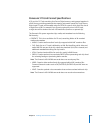
112 Chapter 6 Working with AVCHD
AVCHD Format Specifications
AVCHD is an HD video format that uses Advanced Video Coding (AVC) compression
(also known as MPEG-4 part 10 or H.264).
Storage Medium
AVCHD camcorders record on a variety of file-based media, including 80 mm DVDs
(also known as miniDVDs), hard disks, and flash memory (such as Secure Digital cards).
Video Standard
The AVCHD specification was jointly developed by Sony and Panasonic. AVCHD allows
for HD recording (1080i, 1080p, and 720p) and SD recording (480i and 576i).
Aspect Ratio
AVCHD records HD video with an aspect ratio of 16:9. SD video can be recorded with
either a 4:3 or 16:9 aspect ratio.
Transcoded AVCHD Files Require Significantly More Disk Space
Than Native AVCHD Files
When you ingest AVCHD files using the Log and Transfer window, video is transcoded
to either the Apple ProRes 422 codec or the Apple Intermediate Codec. AVCHD has a
much higher compression ratio than the Apple ProRes 422 codec, so the ingested
files are significantly larger than the original files. For example, a 2-minute native
AVCHD file is about 200 MB. After transcoding to the Apple ProRes 422 codec, the file
size can be as large as 2 GB.
It is possible to exceed the available space on your capture disk during transfer.
Before ingesting AVCHD footage, keep in mind that the disk space required is about
ten times greater than the size of the native AVCHD file. To create smaller files during
transfer, you can transcode AVCHD files to the Apple Intermediate Codec.
To see the size of the source file and an estimated size of the file after transcoding,
you can display Source Size and Target Size columns in the Log and Transfer window.
Control-click a column heading in the Browse area of the Log and Transfer window,
then choose the column heading you want from the shortcut menu. You can also see
the total free disk space available to you in the bottom-right corner of the Transfer
Queue area in the Log and Transfer window.


















